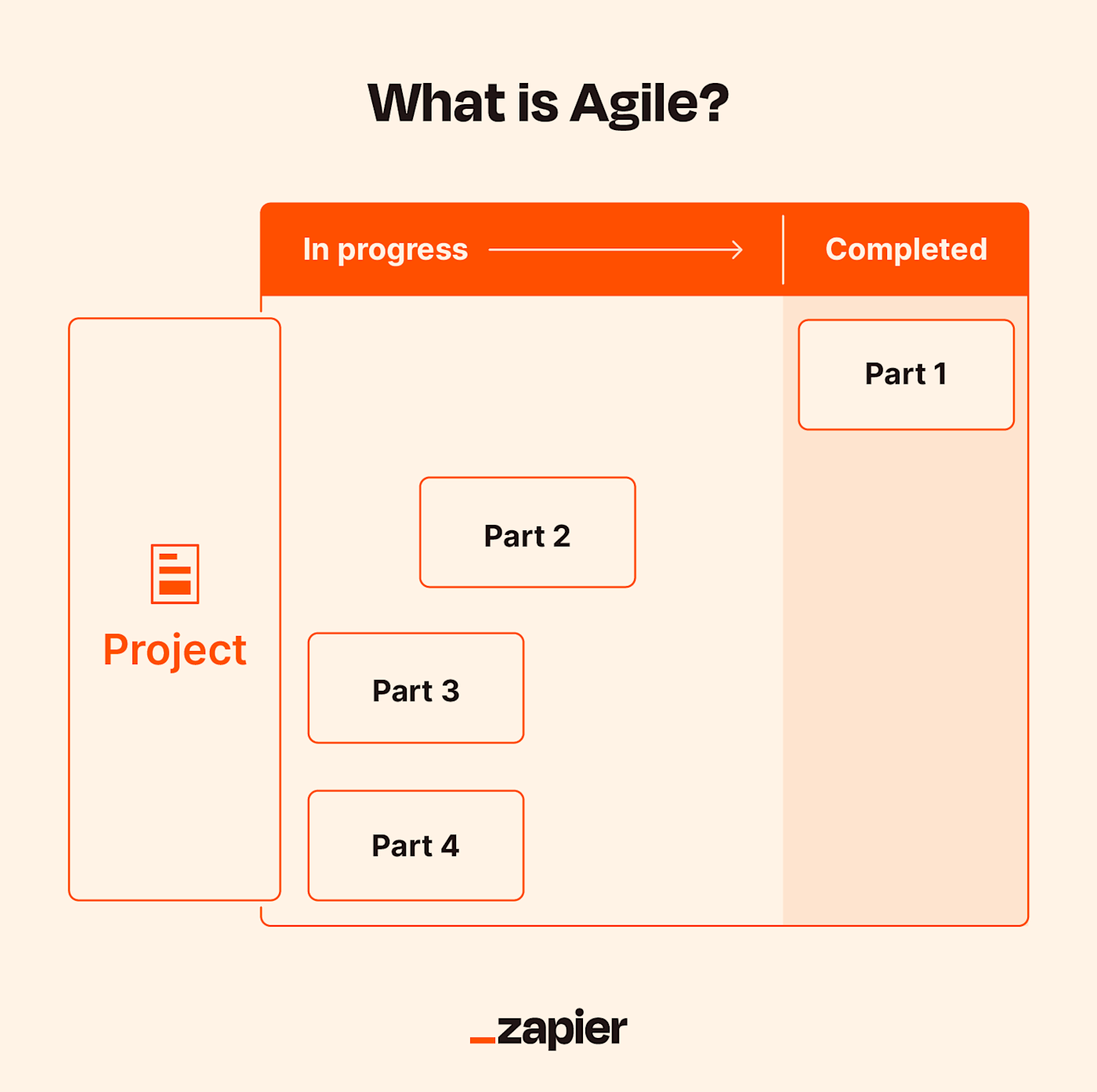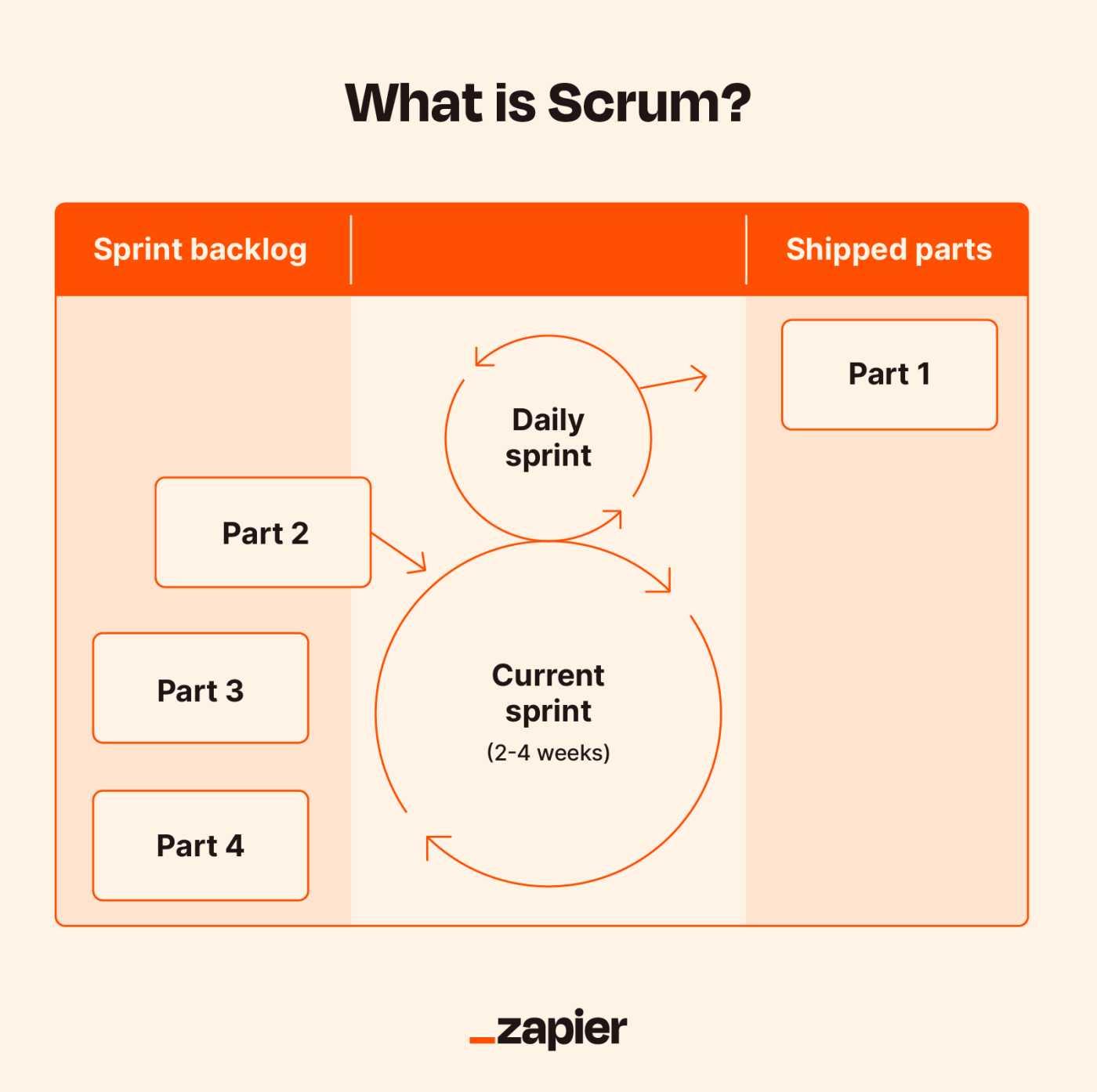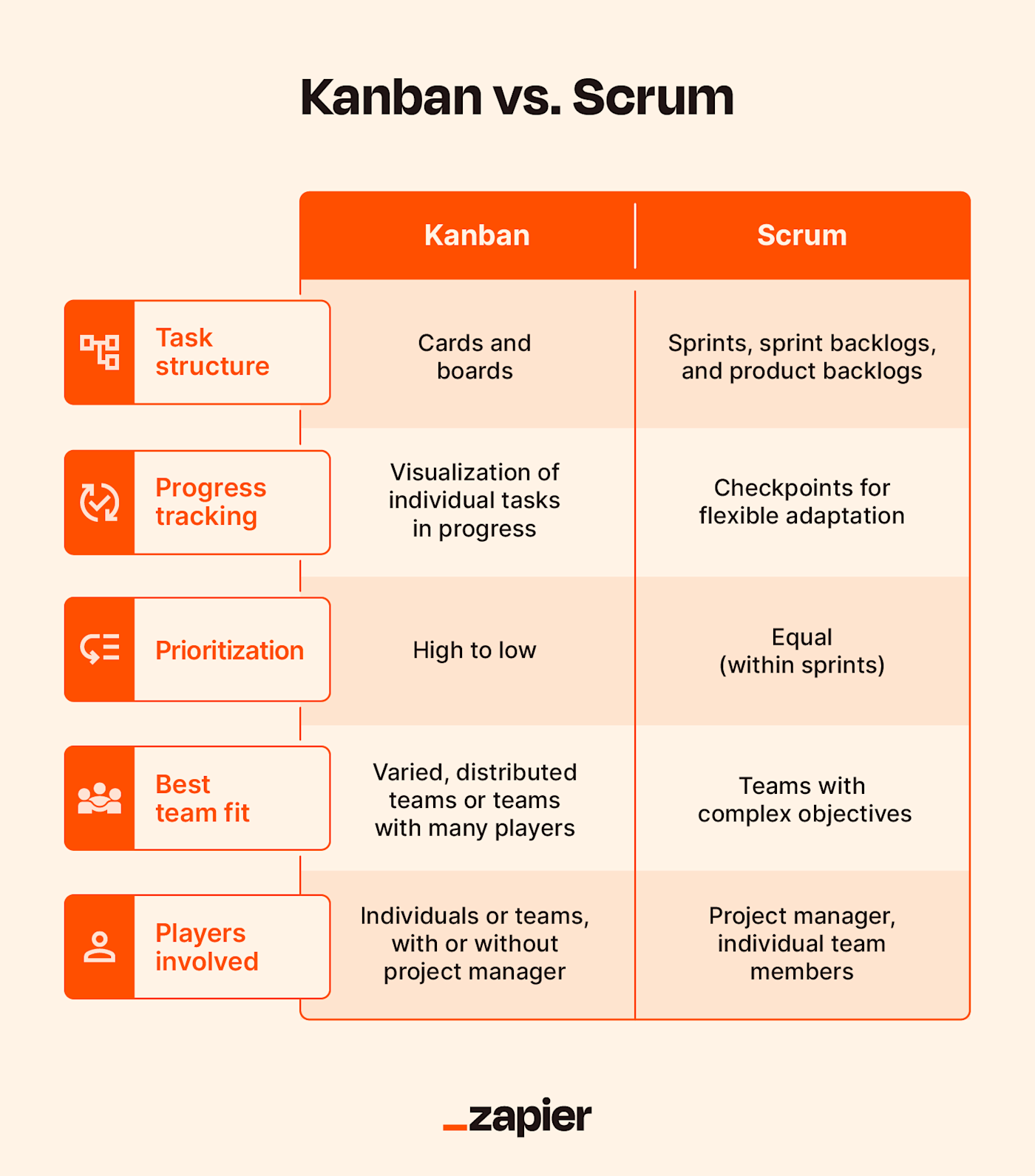Kanban is a card-based task process visualization tool that can be used on its own or as part of methodologies like Scrum, which is an organizational approach for helping teams manage and optimize complex tasks over time. Both can be incorporated into the broader Agile project management philosophy.
As anyone who's ever tried to slice a tomato with a dull knife will tell you, mise en place is a lot easier if you take the time to sharpen your knife first. That's why I make it a point to try to find the most appropriate project management tactic for a job before I get to work.
My go-to approach is the "waterfall"-style breakdown of linear steps I can progress through one by one. But when a given project turns out to be more complicated than usual because it incorporates multiple team members, collaboration across teams, or industries that involve additional complexities, that one-by-one waterfall trickle can turn into an unmanageable cascade.
In these cases, a more flexible Agile approach makes more sense. While some people mistakenly think of this as a separate concept to pit against Kanban vs. Scrum methodologies, it's actually more of an umbrella they can fall under. Here's how the three terms break down.
Table of contents:
What is "agile" project management?
Agile project management (with a little "a") is any application of the greater Agile methodology to help workflows become more responsive. With an agile framework, project managers simplify complex goals into separate groups of tasks for teams to handle in sequences that make sense for their personnel but may not be linear. Agile projects are fluid and adaptive rather than prescriptive.
Agile methods are most popular in industries where projects contain many moving parts and a lot of unknowns, like product and software development. Since Kanban and Scrum are commonly associated with agile, you can think of them as follows:
Agile is an overarching philosophical concept for project management.
Kanban helps organize tasks within a project.
Scrum is an organizational structure.
You could technically use all three concepts at the same time and none would cancel another out. But each concept can also be used separately depending on what the project's priorities are.
What is Agile methodology?
As a proper noun, "Agile" refers to the original agile management framework from which other agile approaches have been derived. Conference planners conceived Agile in 2001 to help project manage for the booming software development industry. In their manifesto, they outlined Agile's fundamental tenets as:
"Individuals and interactions over processes and tools"
"Working software over comprehensive documentation"
"Customer collaboration over contract negotiation"
"Responding to change over following a plan"
In practice, Agile methodology is much more flexible than the traditional waterfall approach, which depends on tasks falling in a simple order. Instead, Agile arranges tasks into groupings of smaller projects that, rather than leading to other steps like dominoes, simply build up to the completion of the overall project goal. By reducing a big, complex outcome into separate pieces, tasks can be divided up, so team members can meet individual timelines and adapt as needed.

The benefits of Agile management include:
Faster delivery times
More collaboration
The ability to continuously incorporate customer feedback and adapt to market changes
The trade-off is that Agile projects are more susceptible to scope creep, as the parameters of the project aren't strictly defined. If you're not careful, tasks can get added to the project and it'll balloon into something unmanageable.
Agile is ideal for:
Organizing projects with a lot of separate parts
Applying changes to projects as they move down the pipeline
Helping teams collaborate effectively
Agile is kind of like a team scavenger hunt. The items on the list don't need to be found in order, and the entire team doesn't need to help find each and every one, so you're better off splitting the list up and having parts of the team work on finding different things at the same time. If one group runs into trouble or gets stuck, the other groups can keep working—it allows the team as a whole to keep progressing even if a part of the team hits an obstacle.
Agile software
Since Agile is a general philosophy rather than a hard-and-fast practice, really any project management platform that isn't waterfall/Gantt chart-specific will work well for Agile projects.
Explore the differences between Trello vs. Jira, two common tools that help teams apply agile methodologies.
What is Kanban?
Kanban isn't a separate methodology from Agile: it's an approach that can be used in tandem with Agile and other flexible project management styles.
In fact, Kanban was developed long before Agile was even a thing. It was first developed in the 1940s by a Toyota executive named Taiichi Ohno, and is today recognized as an "agile" project approach because it prioritizes similar values like adaptability, efficiency, and improved collaboration.
The Kanban approach is a means of visualizing a project's status and progress via Kanban boards. (The Japanese word "kanban" means "billboard.") A Kanban board is divided into columns representing different stages of completion, like "not started," "in progress," and "complete." Tasks are sorted into columns and tagged with information, like priority level, person working on it, and project status.

There's no real wrong way to structure a Kanban-style task visualization (typically referred to as a Kanban board), but there are four key concepts that can help you stay on track using Kanban:
Separate tasks into individual cards and consolidate all relevant information, documentation, and assets with them.
To stave off burnout and maintain efficiency, put a realistic limit on the number of cards an individual can juggle at one time while ensuring at least one task is always being advanced.
Prioritize cards by importance.
Never stop scrutinizing the overall performance to ensure efficiency is constantly improving (also called kaizen).
Kanban doesn't compete with Agile—in fact, it's often used as part of an agile project management approach. Teams can use Kanban boards to help them keep track of their Scrum sprints or stay organized across departments. Just be aware that Kanban doesn't solve any pre-existing workflow issues, like Scrum may be able to, since it's really more of an organizational tool. If the top card in your "To Do" list falls behind and the remaining cards in the list can't start until the top card is completed, it will still cause delays.
Kanban is best for:
Projects involving many teams and players
Distributed teams that need a central project plan
Teams that prefer highly visual project and progress tracking
If you're the type who always starts their project with a big whiteboard, or who maintains a massive wall of sticky notes, or if your project management system ever makes you feel like you're looking for Pepe Silvia, then Kanban boards are for you.
Kanban software
Trello made its name as the original digital Kanban tool, but nowadays many project management platforms offer Kanban views alongside calendars, Gantt charts, and task lists. Here's a list of the best Kanban software.
Learn how to automate a Kanban board to update tasks automatically.
What is Scrum?
Scrum, unlike Agile and Kanban, is a prescriptive structure for managing projects that requires a manager, a team, a predetermined short timeline, and regular progress reporting. A Scrum project uses the following structure:
The project manager, or "Scrum Master," works with their team to identify the set of tasks to be accomplished and organizes them into a "product backlog." This project manager will then arrange smaller sets of tasks into even smaller units of tasks called a "sprint backlog."
The team enters a finite period (typically two to four weeks) called a "sprint." The entire team works through the sprint to complete the tasks in the established backlog, but there's no predefined map or order of priorities for completing these tasks.
As the team progresses through the sprint at their own pace, the project manager leads short meetings called standups every day, during which the team members report their progress and any challenges they've run into.
During a "sprint retrospective" after a sprint, individual team members share their experiences to help identify strengths and weaknesses with the goal of improving the efficiency of upcoming sprints.
Sprints are flexible by design, allowing priorities to change on the fly and ensuring team members are equipped to pivot as needed as unforeseen complications arise.

Scrum is best for:
Teams with complex, multifaceted objectives
Projects in inherently dynamic industries, like development and tech
Teams working on a product that is actively being used or tested by customers providing feedback
Scrum is the tool to use if your projects change so frequently that they start to feel a bit like a game of Whac-a-Mole, with tiny changes and updates appearing too quickly for a less flexible project management system to adjust.
Scrum software
The best software platforms for Scrum teams are purpose-built for sprint planning and offer features like backlog management and the ability to organize product versions, features, and releases. Jira is a popular example here.
Scrum vs. Agile
Since Scrum is one of the most popular forms of Agile project management (if not the most popular), Scrum is sometimes confused with Agile or used interchangeably with it. But Scrum is simply a project framework that fits into the Agile philosophy. Scrum can be considered agile, but Agile as a philosophy includes many more approaches than Scrum.
Applying Agile methodology: Kanban vs. Scrum
If you're deciding between Kanban vs. Scrum, first remember that they aren't mutually exclusive approaches to managing projects. A Kanban board can be a great tool for tracking individual tasks within a Scrum sprint or organizing an entire sprint or product backlog. But they do have some distinct scenarios they're ideal for.

Agile vs. waterfall
Agile can be viewed in opposition to a more straightforward waterfall approach to project management, as it allows for more nimble movement from task to task and project to project, whereas waterfall moves linearly from one task to the next. Within an agile-style project, teams and individuals can prioritize tasks within groups or cycles as needed, while waterfall projects require a given task to be completed before subsequent tasks can be started.
Many project managers find that an agile approach works best because it allows them to break down projects into more manageable component parts that can be distributed amongst team members. Meanwhile, others find that a waterfall approach is necessary because a complex project requires one team member to complete their task or set of tasks before the next one can proceed.
Which project management methodology should you use?
The Kanban vs. Scrum debate will ultimately come down to how your business or organization is structured and whether you think visualization will help organize tasks. It's not a zero-sum game, though, so it may make sense to apply both to a dispersed team with complex projects and many sub-tasks. You might even find that a more sequential waterfall approach is preferable to an agile one.
In summary:
Kanban is a great fit for teams that would benefit from visualizing tasks to keep them organized.
Scrum can help teams handle inherently complex tasks or meet goals by organizing them into short, flexible sprints.
Agile projects work best for teams with broad goals by allowing them to adapt to changing deadlines, needs, or priorities.
Waterfall frameworks can be effective when tasks or projects require clearly defined linear sequences.
Whichever project management philosophy or methodology you choose, Zapier's no-code automation can help your team move from start to finish.
Related reading:






